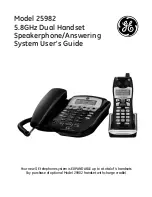
Primer
Crestron
Surround Sound
channels so that the two sides of an LP groove carried four playback
channels. This four-speaker system required a decoder and a separate
rear channel amplifier. Problems with system standardization prevented
technological development.
Dolby
In the mid 1970's, Dolby Laboratories (www.dolby.com) devised a
method to encode additional audio channels. This technology, initially
known as Dolby Stereo when it was launched in 1975, was later
renamed Dolby Surround.
In 1982, Dolby Surround and enhanced Dolby Pro Logic playback
decoder became available to the consumer. Dolby Surround, like the
earlier Quadraphonic systems, used channel matrixing to combine four
audio channels into two signals.
Also described as 4-2-4 matrixing, these signals (compatible with two-
speaker stereo playback) can be decoded into multiple channels.
Basic Dolby Surround decoding yields: front left, front right, and one
surround channel (the center channel is a phantom).
The 4-2-4 encoder accepts four separate inputs (left, right, center and
surround) and creates two outputs (left-total and right-total). The front
left and right channels are a regular stereo signal. The center channel is
inserted equally in the left and right channel, with a 3 dB level
reduction to maintain constant acoustic power.
Dolby 4-2-4 Encoding
The surround input is also divided equally between the left-total and
right-total signals but first undergoes three processing steps:
•
It is frequency band-limited from 100 Hz to 7 kHz
•
It is encoded with a modified Dolby B-type noise reduction
10
•
Surround Sound
Primer – DOC. 6122















































